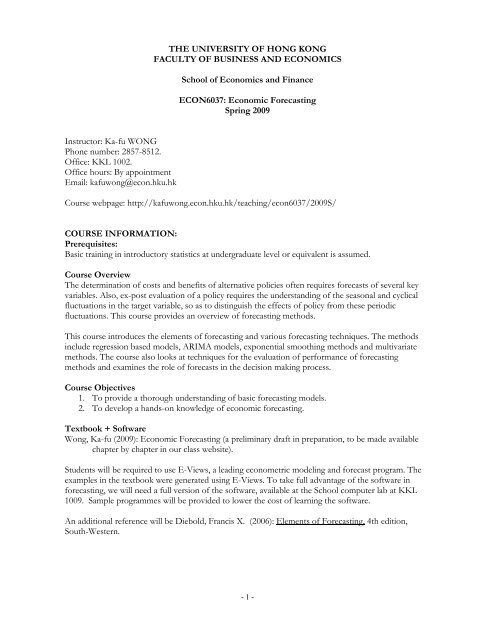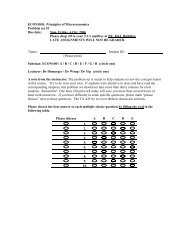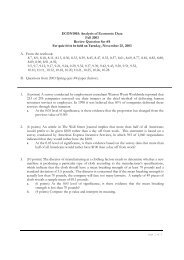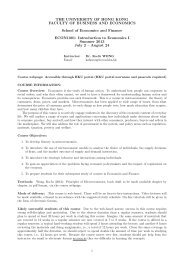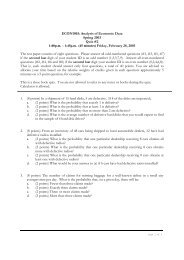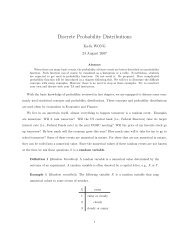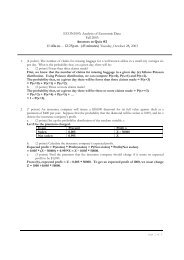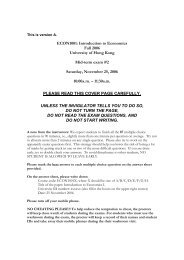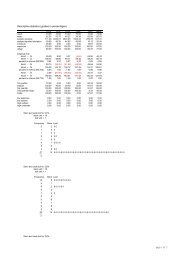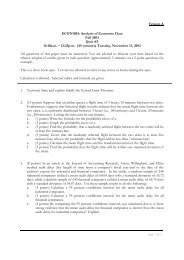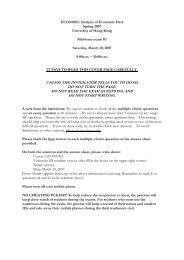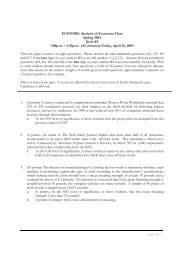Syllabus / reading list - Ka-fu Wong - The University of Hong Kong
Syllabus / reading list - Ka-fu Wong - The University of Hong Kong
Syllabus / reading list - Ka-fu Wong - The University of Hong Kong
You also want an ePaper? Increase the reach of your titles
YUMPU automatically turns print PDFs into web optimized ePapers that Google loves.
THE UNIVERSITY OF HONG KONGFACULTY OF BUSINESS AND ECONOMICSSchool <strong>of</strong> Economics and FinanceECON6037: Economic ForecastingSpring 2009Instructor: <strong>Ka</strong>-<strong>fu</strong> WONGPhone number: 2857-8512.Office: KKL 1002.Office hours: By appointmentEmail: ka<strong>fu</strong>wong@econ.hku.hkCourse webpage: http://ka<strong>fu</strong>wong.econ.hku.hk/teaching/econ6037/2009S/COURSE INFORMATION:Prerequisites:Basic training in introductory statistics at undergraduate level or equivalent is assumed.Course Overview<strong>The</strong> determination <strong>of</strong> costs and benefits <strong>of</strong> alternative policies <strong>of</strong>ten requires forecasts <strong>of</strong> several keyvariables. Also, ex-post evaluation <strong>of</strong> a policy requires the understanding <strong>of</strong> the seasonal and cyclicalfluctuations in the target variable, so as to distinguish the effects <strong>of</strong> policy from these periodicfluctuations. This course provides an overview <strong>of</strong> forecasting methods.This course introduces the elements <strong>of</strong> forecasting and various forecasting techniques. <strong>The</strong> methodsinclude regression based models, ARIMA models, exponential smoothing methods and multivariatemethods. <strong>The</strong> course also looks at techniques for the evaluation <strong>of</strong> performance <strong>of</strong> forecastingmethods and examines the role <strong>of</strong> forecasts in the decision making process.Course Objectives1. To provide a thorough understanding <strong>of</strong> basic forecasting models.2. To develop a hands-on knowledge <strong>of</strong> economic forecasting.Textbook + S<strong>of</strong>tware<strong>Wong</strong>, <strong>Ka</strong>-<strong>fu</strong> (2009): Economic Forecasting (a preliminary draft in preparation, to be made availablechapter by chapter in our class website).Students will be required to use E-Views, a leading econometric modeling and forecast program. <strong>The</strong>examples in the textbook were generated using E-Views. To take <strong>fu</strong>ll advantage <strong>of</strong> the s<strong>of</strong>tware inforecasting, we will need a <strong>fu</strong>ll version <strong>of</strong> the s<strong>of</strong>tware, available at the School computer lab at KKL1009. Sample programmes will be provided to lower the cost <strong>of</strong> learning the s<strong>of</strong>tware.An additional reference will be Diebold, Francis X. (2006): Elements <strong>of</strong> Forecasting, 4th edition,South-Western.-1 -
INTENDED LEARNING OUTCOMESOn completion <strong>of</strong> this course, students should be able to:CILO1. Collect data, select the appropriate model to produce out-<strong>of</strong>-sample forecast, and write ashort report based on the results.CILO2. Understand and evaluate basic forecasting results <strong>of</strong> research reports.ALIGNMENTS OF PROGRAM AND COURSE LEARNING OUTCOMES:Program Intended Learning Objectives1. To master current theory and knowledge inthe field <strong>of</strong> economics2. To master the skills to deal with economicdata.3. To develop the ability to apply economics toreal world problems.4. To develop global and regional outlook andastutenessCourse Intended Learning Objectives(CILOs)CILO1, CILO2CILO1, CILO2CILO1, CILO2CILO1TEACHING AND LEARNING ACTIVITIESTLA1.TLA2.TLA3.Lectures:Instructor will give lectures on major concepts and issues.Homework:Students will be asked to produce forecast using different datasets and forecastingtools covered.Consultation:<strong>The</strong> instructor holds weekly consultation hours to address students’ questions.Students are also encouraged to discuss questions with the instructor by email or aforum in the class website.ASSESSMENTAssessmentWeightsA1. Homework assignments 50%A2. Project 50%A3. Forecast competition (bonus, maximum 20%)Homework assignments: Homework assignments will be given on an approximately bi-weekly basisand these will account for approximately 50% <strong>of</strong> students’ grade. <strong>The</strong> aim is to let students practice thebasic elements <strong>of</strong> forecasting. Each student will have to work on a different economic time series fromthe other students. Students will have to upload a Powerpoint file (along with the Eviews work file andprogram) summarizing the findings.<strong>The</strong> homework assignments will be assessed on the following aspects:(1) Statistical Analysis: 60%(2) Clarity (Readability): 40%-2 -
Project: <strong>The</strong> aim is to get student to practice the preparation <strong>of</strong> a complete forecast report for thegovernment or a private firm. A formal written report has to be submitted within one week after theend <strong>of</strong> the course. <strong>The</strong> written report will be worth 50% <strong>of</strong> your grade.Students can choose any project, subject to the approval <strong>of</strong> the instructor. One excellent possibility isto work on an actual forecasting project with a local business. Another possibility is to forecast thestock performance <strong>of</strong> <strong>list</strong>ing firms. All projects must have an Asian context (preferably <strong>Hong</strong> <strong>Kong</strong>, Macau,Taiwan or China).<strong>The</strong> paper (text, graphs and tables inclusive) is restricted to a maximum <strong>of</strong> 15 pages, double-line spacedwith Times Roman 12 pts, and margins <strong>of</strong> 1 inch from all sides. A topic should be submitted to“project topic wiki” starting 10:00p.m. Friday, March 14. <strong>The</strong> paper (along with the Eviews workfileand program) is due at 10:00p.m. Friday, May 2, both via the course website.To guard against plagiarism, all submitted papers will be scanned by Turnitin.<strong>The</strong> term paper will be assessed on the following aspects:(1) Abstract: 5%(2) Motivation/Objective: 10%(3) Statistical Analysis: 40%(4) Clarity (Readability): 30%(5) Citation/Reference: 10%(6) Format Conformity (page margin, line spacing, font size, etc.): 5%Forecast competition (Bonus, maximum 20%): Students are inivted to forecast the weekly closing<strong>of</strong> Hang Seng Index. All competitors have to submit their forecasts on Sunday for the followingweek’s closing. It has to be submitted to the course website with a brief discussion on how theforecast was obtained. <strong>The</strong> instructor will also produce a forecast as a benchmark. <strong>The</strong> n students whoconsistently perform better than the instructor will share the bonus equally, i.e., each gets 20/n bonuspoints. More will be discussed on the first day <strong>of</strong> class.Relationship Among Intended Learning Outcome, Teaching And Learning Activities AndAssessmentsCILO Teaching and Learning Activities (TLA) Assessments (A)1 2 3 1 2 31✓ ✓ ✓ ✓ ✓ ✓2✓ ✓ ✓ ✓ ✓ ✓STANDARDS OF ASSESSMENTOverall grades are given using the following criteria:Grade PerformanceA+, A, A- > 80B+, B, B- 65 - 80C+, C, C- 50 - 65D+, D 40 - 50F < 40-3 -
ACADEMIC CONDUCT<strong>The</strong> <strong>University</strong> Regulations on academic dishonesty will be strictly enforced! Please check the<strong>University</strong> Statement on plagiarism on the web: http://www.hku.hk/plagiarism/Academic dishonesty is behavior in which a deliberately fraudulent misrepresentation is employed in anattempt to gain undeserved intellectual credit, either for oneself or for another. It includes, but is notnecessarily limited to, the following types <strong>of</strong> cases:a. Plagiarism - <strong>The</strong> representation <strong>of</strong> someone else’s ideas as if they are one’s own. Where thearguments, data, designs, etc., <strong>of</strong> someone else are being used in a paper, report, oralpresentation, or similar academic project, this fact must be made explicitly clear by citing theappropriate references. <strong>The</strong> references must <strong>fu</strong>lly indicate the extent to which any parts <strong>of</strong> theproject are not one's own work. Paraphrasing <strong>of</strong> someone else's ideas is still using someoneelse’s ideas, and must be acknowledged.b. Unauthorized Collaboration on Out-<strong>of</strong>-Class Projects - <strong>The</strong> representation <strong>of</strong> work as solelyone's own when in fact it is the result <strong>of</strong> a joint effort.Where a candidate for a degree or other award uses the work <strong>of</strong> another person or persons withoutdue acknowledgement:1. <strong>The</strong> relevant Board <strong>of</strong> Examiners may impose a penalty in relation to the seriousness <strong>of</strong> the<strong>of</strong>fence;2. <strong>The</strong> relevant Board <strong>of</strong> Examiners may report the candidate to the Senate, where there is primafacie evidence <strong>of</strong> an intention to deceive and where sanctions beyond those in (1) might beinvoked.CLASS SCHEDULEWeek Topic1 <strong>The</strong> Basic Issues2 Modeling and Forecasting TrendModeling and Forecasting Seasonality3-4 Characterizing Cycles5-6 Modeling Cycles: MA, AR, and ARMA Models7 Forecasting Cycles8 A Forecasting model with Trend, Seasonal, and Cyclical Components9 Forecasting with Regression Models10 Evaluating and Combining Forecasts11 Unit Roots, Stochastic Trends, ARIMA Forecasting Models, and Smoothing12 Volatility Measurement, Modeling and Forecasting-4 -


